An iron bridge collapse over the Indrayani River in Maharashtra state’s Pune district on June 15, 2025, killed four people and injured dozens more, according to state officials. The incident occurred around 3:30 p.m. local time in the Kundamala area of Maval tehsil, a popular tourist destination that had attracted scores of visitors despite recent heavy rainfall in the region.
Maharashtra Chief Minister Devendra Fadnavis confirmed the casualties, with reports indicating that 38 to 51 people sustained injuries in the collapse. Six individuals were hospitalized in critical condition following the incident. Local media reported that numerous tourists were on the bridge when it gave way, plunging many into the swollen river below.
The 33-year-old pedestrian bridge, constructed in 1993 by the Pune Zilla Parishad, had been declared dangerous by district authorities prior to the collapse. Fadnavis revealed that the collector had deemed the structure unsafe and warning signboards had been installed at the site. Despite these precautions, approximately 125 tourists had gathered at the location for monsoon sightseeing when the bridge failed under the weight of the crowd.
Search and rescue operations commenced immediately following the collapse, with two teams from the National Disaster Response Force deployed to the scene. Local police, fire brigade personnel, and various rescue organizations participated in the recovery efforts. Officials reported that 38 people were successfully rescued from the incident site, though some individuals were swept away by the river’s strong current caused by recent heavy rainfall.
Among the deceased, three victims have been identified as Chandrakant Sathale, Rohit Mane, and Vihan Mane, while one remains unidentified. Two people died from injuries sustained during treatment after being rescued, while two additional bodies were recovered from beneath the collapsed bridge structure. Maharashtra Disaster Management Minister Girish Mahajan, who supervised relief operations at the site, indicated that one person might still be trapped under the debris.
The bridge collapse prompted immediate government response from the highest levels. Prime Minister Narendra Modi, currently visiting Cyprus, contacted Fadnavis to discuss the incident and offered any necessary resources to the Maharashtra state government. Union Home Minister Amit Shah also spoke with the chief minister regarding the emergency response efforts.
Maharashtra Deputy Chief Minister Ajit Pawar examined the scene and determined that the iron bridge was rusted and deteriorated. He noted that the structure appeared to have failed due to overcrowding, with many people standing on the bridge simultaneously. Local legislator Sunil Shelke explained that the bridge was originally constructed for farmer movement 30 years ago but had been overwhelmed by tourist traffic and two-wheelers in recent years.
Authorities had previously recognized the bridge’s deteriorating condition and taken preventive measures. In 2023, the administration observed that the structure was in dilapidated condition after nearly three decades of use and prohibited further public access. A new bridge construction project worth 8 crore rupees had been proposed, with the Public Works Department issuing tenders and work orders. Construction was scheduled to begin after the monsoon season.
The state government announced financial assistance for victims and their families. Fadnavis confirmed compensation of 5 lakh rupees (approximately $5,800) would be provided to families of the deceased, while the government would cover all medical expenses for injured victims. The announcement drew some public criticism regarding the relatively modest compensation amount compared to other recent aviation disasters.
The incident highlights ongoing infrastructure safety concerns across India, where aging bridges and structures pose significant risks. In 2022, a century-old cable suspension bridge collapsed in Gujarat state, killing at least 132 people in one of the country’s worst accidents of the past decade. Officials noted that Pune district alone has identified approximately 500 similar dangerous locations requiring attention.
Weather conditions contributed to the severity of the incident, with the Pune district experiencing heavy rainfall over several days prior to the collapse. The precipitation had caused the Indrayani River to swell, creating stronger currents that swept away some victims. However, it was not raining at the time of the actual bridge failure, according to local reports.
Rescue operations continued through the night and into the following day, with authorities using cranes to remove collapsed portions of the bridge structure. Emergency teams maintained their search efforts despite challenging weather conditions, focusing on locating any remaining victims who might be trapped beneath the debris.








